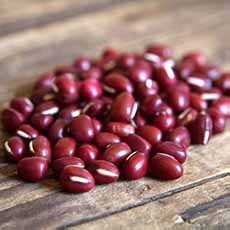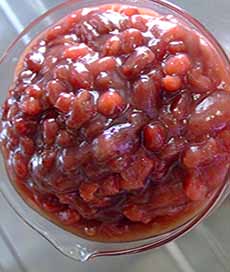A Lady M Red Bean Mille Crepes Cake With Azuki Beans
|
January 9th is National Bean Day, so we’re featuring a bean that Asian cultures use in sweet recipes: The azuki bean (also spelled adzuki, and also called red beans and red mung beans). The Lady M Red Bean Mille Crêpes Cake, filled with azuki beans, is a luxurious cake for today, the Lunar New Year, or Valentine’s Day. To make things perfectly authentic, the beans come from Hokkaido, Japan. The cake, which serves 10-24 people (or one person who likes to eat large slices, several days in a row), is made from azuki beans, the bean used in red bean ice cream, and other Japanese desserts. Lady M’s classic handmade crêpes are layered with silky whipped red bean pastry cream and topped with a delicate dusting of powdered sugar. But fear not, today we have a magnificent cake for the gourmet: Lady M’s Red Bean Mille Crêpes Cake We’ve reviewed other flavors of Lady M Crêpes Cake, one of our favorite cakes.! Head to Lady M to get yours! The azuki bean, also spelled azuki bean and aduki bean, and called red bean or red mung bean in English (Vigna angularis), is an annual vine widely cultivated throughout East Asia for its small red* bean. In East Asian cuisine, the azuki bean is commonly sweetened before eating, often boiled with sugar, producing red bean paste. It also is common to add flavoring to the bean paste (chestnut is popular). Red bean paste is used in many Chinese dishes, including ice cream and mooncakes, baozi, and red bean ice. It can be used as a filling or topping for various types of waffles, pastries, baked buns, and biscuits/cookies. They are also used to make a hot, tea-like drink. > The different types of beans. > The history of Mille Crêpes Cake. Like other types of beans and peas, they are part of the legume family, Fabaceae. Like other family members, they share nutrition and health benefits. There are at least 60 varieties of adzuki beans, grown in more than 30 countries (the largest producer is China) [source]. The wild ancestor of today’s cultivated azuki bean is believed to be Vigna angularis var. nipponensis, which grows wild across Japan, Korea, China, Nepal, and Bhutan. The evolution of var. angularis from var. nipponensis, the variety used in the Lady M cake, occurred around 50,000 years ago. Archaeologists have found evidence of domestication around 3000 B.C.E. Domestication of azuki beans necessitated a trade-off between yield and seed size. Cultivated azuki beans have fewer but longer pods, fewer but larger seeds, a shorter stature, and also a smaller overall seed yield than wild varieties [source]. There are at least 60 varieties of azuki beans, and they’re grown in more than 30 countries, especially China. |
|
|
|
USES FOR AZUKI BEANS You can buy dry azuki beans at many Asian supermarkets or other specialty stores. If you’re buying canned azuki beans, check the label to see if they are sweetened/ Like other legumes, azuki beans are healthy substitutes for meat. You can: Azuki beans are found in many Japanese sweets and desserts, including anpan (filled sweet rolls), jellies, mochi, and pancakes. In Chinese cuisine, azuki beans, whole or mashed into pastes, are found in mooncakes, tangyuan (rice balls served in a hot broth or syrup), steamed buns, steamed rice dumplings, and sweet soups. CHECK OUT WHAT’S HAPPENING ON OUR HOME PAGE, THENIBBLE.COM. |
||






